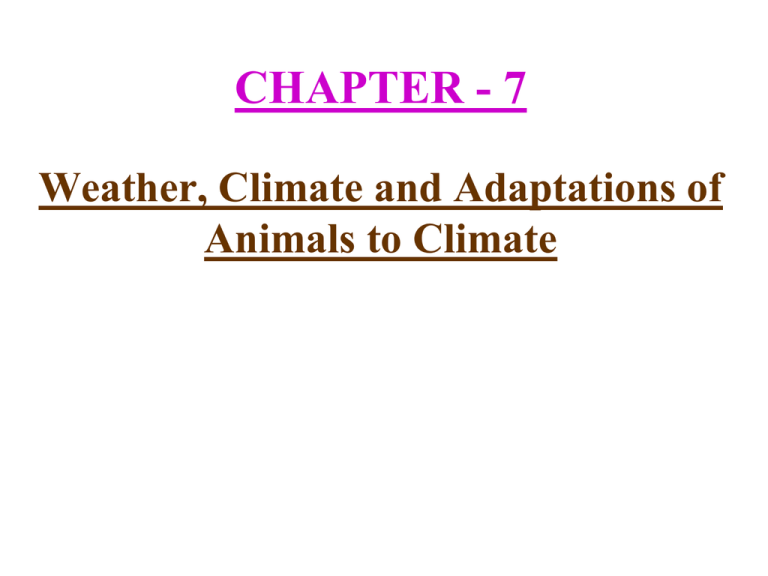File
advertisement

CHAPTER - 7 Weather, Climate and Adaptations of Animals to Climate 1) Weather :The day to day condition of the atmosphere at a place with respect to temperature, humidity, rainfall, wind speed etc. is called the weather at that place. The temperature, humidity, rainfall, wind speed etc. are called the elements of the weather. The weather at a place changes every day. Sometimes it is more warm, more humid, more cloudy or more windy. Sometimes it is less warm, less humid, less cloudy or less windy. Sunny Windy Cloudy Rainy 2) Changes in weather :The weather is generally not the same on any two days and there is a lot of changes in the weather over weeks and months. All the changes in the weather is caused by the sun. From the weather report of news paper, record the information in the table below and observe the changes in temperature, humidity and rainfall for a week. Date 7 – 9 – 09 8 – 9 – 09 9 – 9 – 09 10 – 9 – 09 11 – 9 – 09 12 – 9 – 09 13 – 9 – 09 14 – 9 – 09 Max. Temp. oC Min. Temp. oC Max. Humidity % Min. Humidity % Rainfall (mm) 3) Climate :The average weather pattern taken over a long period of time ( about 25 years ) is called the climate of the place. If the temperature of a place is hot for most of the days and if there is more rainfall, then we say that the climate of the place is hot and wet. Eg :- Kerala If the temperature at a place is hot for most of the days and if there is less rainfall, then we say that the climate of the place is hot and dry. Eg :- Rajasthan 4) Climate and adaptations of animals :Animals living in very cold climate and very hot climate should have special features to protect them from heat and cold. a) The polar regions :The polar regions are very cold for most parts of the year and the temperatures are as low as – 37 o C. For six months the sun does not rise and for six months the sun does not set. Some of the animals found in the polar regions are polar bear, penguins, musk oxen, reindeers, foxes, seals, whales, Siberian crane etc. Adaptations of polar bear :i) They have white fur so that they are not easily visible in the snow and helps in catching their prey. ii) They have two layers of fur to protect them extreme cold. iii) They have a layer of fat under the skin which also protect them from cold. iv) Their paws are wide and large which help them to walk on snow and to swim in water. v) They have a strong sense of smell which helps them to catch their prey. Polar bears Adaptations of penguins :i) They have white coloured body so that they are not easily visible in the snow. ii) They have thick skin and a lot of fat to protect them from cold. iii) They huddle together to keep them warm. iv) They have streamlined body and webbed feet which help them to swim in water. Reindeers Foxes Seals Whales Musk oxen Adaptations of Siberian crane :The Siberian crane must keep its body warm to survive in winter. So during winter it migrates to far away warmer places. Siberian cranes come to places in India like Bharatpur in Rajasthan and Sultanpur in Haryana to escape from the extreme winter in Siberia. b) The Tropical rainforests :The tropical regions have a hot climate. The minimum temperature is more tan 15 oC and maximum temperature is more than 40 oC. The days and nights are of almost equal length. These regions also have plenty of rainfall. The tropical regions in India are western ghats and Assam. In the world the tropical regions are South east Asia, Central America and Central Africa. The common animals found in tropical climate are monkeys, apes, gorillas, lions, tigers, elephants, leopards, snakes, lizards, insects, birds etc. Adaptations of red eyed frog :The red eyed frog lives on trees. It has sticky pads on its feet which helps it to climb on trees. Adaptations of monkeys :Monkeys live on trees. They have long tails for grasping branches. Their hands and feet also help them to hold on to branches. Adaptations of toucan :Toucans live on trees. They have a long large beak which help them to reach the fruits on branches. Adaptations of lions and tigers :Lions and tigers have thick brown skin which help them to hide easily in the forests. They have sensitive hearing and sharp eye sight which help to protect them from predators and to catch their prey. Adaptations of lion tailed macaque (beard ape) :The lion tailed macaque mostly lives on trees. It feeds on fruits, leaves, stems, flowers, buds and insects which it gets from the trees. Adaptations of the elephant :The elephant has a long trunk which it uses as nose and for picking up food. It has a strong sense of smell. The tusks are modified teeth which helps it to tear barks of trees to eat. Its large ears help it to hear even soft sounds. It also helps it to cool itself in hot climate.











